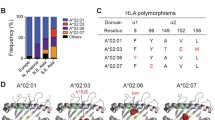Abstract
CYTOTOXIC T lymphocytes generated in mice by immunisation with syngeneic Friend virus (FV)-induced tumour cells show H–2 restriction, that is, their cytotoxicity is specific not only for FV-associated antigenic determinants expressed on the surfaces of potential target cells but also for products of genes associated with the major histocompatibility complex, H–2 (ref. 1). We report here the results of studies concerning the role of molecules governed by genes in the K and D regions of the H–2 complex in the stimulation of FV-specific immune responses. Studies in other viral systems have shown that H–2-restricted T-cell killing can be associated with either K or D region determinants, that is, cytotoxic T cells from virus-infected mice will kill virus-infected target cells which share either the K or D region with the infected strain2. Our studies, however, indicate that in the FV system there is a selective participation of H–2 determinants in virus-specific killing by cytotoxic T cells: BALB.B mice immunised with cultured, syngeneic FV-mduced tumour cells produce T cells with a cytotoxicity for other FV-induced tumour cells which depends only on identity at the H–2D (and not the H–2K) region of the H–2b haplotype. This H–2Db restriction in FV-specific cytotoxicity correlates with previous observations concerning: (1) partial co-capping of H–2Db and not H–2Kb specificities following treatment with anti-FV antiserum3; (2) selective incorporation of H–2Db and not H–2Kb specificities into mature FV particles4; and with our present observation of (3) blocking of T-cell cytotoxicity by anti-H–2Db and not anti-H–2Kb antisera. We suggest that the basis for this correlation is the formation of H–2Db/viral protein complexes on the surfaces of FV-infected cells, forming an ‘altered self’ molecule recognised by cytotoxic T cells as previously proposed for the mechanism of H–2 restriction5.
Similar content being viewed by others
References
Blank, K. J., Freedman, H. A., & Lilly, F. Nature 260, 250–252 (1976).
Doherty, P. C. & Zinkernagel, R. M. J. exp. Med. 141, 502–508 (1975).
Bubbers, J. E., Steeves, R. A. & Lilly, F. Proc. Am. Ass. Cancer Res. 17, 93 (1976).
Bubbers, J. E. & Lilly, F. Nature 266, 458–459 (1977).
Zinkernagel, R. M. & Doherty, P. C. Nature 248, 701–702 (1974).
Freedman, H. A. & Lilly, F. J. exp. Med. 142, 212–223 (1975).
Berke, G., Sullivan, K. A. & Amos, D. B. J. exp. Med. 135, 1334–1348 (1972).
Shrader, J. W. & Edelman, G. M. J. exp. Med. 143, 601–614 (1976).
Lilly, F. J. exp. Med. 127, 465–473 (1968).
Author information
Authors and Affiliations
Rights and permissions
About this article
Cite this article
BLANK, K., LILLY, F. Evidence for an H–2/viral protein complex on the cell surface as the basis for the H–2 restriction of cytotoxicity. Nature 269, 808–809 (1977). https://doi.org/10.1038/269808a0
Received:
Accepted:
Issue Date:
DOI: https://doi.org/10.1038/269808a0
- Springer Nature Limited
This article is cited by
-
H-2-specific antibodies induced by injection of syngeneic leukemia cells
Immunogenetics (1987)
-
Resistance to cell-mediated cytotoxicity is correlated with reduction of H-2K gene products in AKR leukemia
Immunogenetics (1982)
-
Production of anti-self H–2 antibodies by hybrid mice immune to a viral tumour
Nature (1981)
-
Independence of H-2 and viral antigens on the cell surface and absence of H-2 antigens on murine leukemia virus and mouse mammary tumor virus particles
Immunogenetics (1981)





